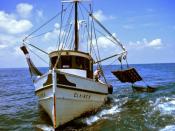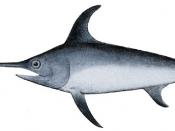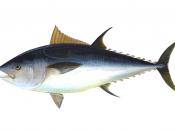Fishing is one of the oldest and most traditional methods of gathering food and promoting commerce. As early as the first century B.C., fisheries were harvesting pearls to sell as jewelry (Kunz and Stevenson, 1908). Fisheries have existed for over two thousand years, and remain prominent today. In recent years, new technologies have revolutionized the methods used to catch marine animals. Ironically, however, these methods may be creating a grim future for the fishing industry, as well as the marine ecosystem. Over-fishing has resulted in dangerously low numbers of certain marine species, primarily large predators, as well as rapidly drying revenue streams for fisheries.
One species that has suffered greatly from the onslaught of the new fishing arsenals is the giant bluefin tuna. Fen Montaigne, a journalist for National Geographic, eloquently describes this incredible creature, and the threat it faces from fisheries, in his article entitled, Still Waters: The Global Fish Crisis.
He describes the bluefin as being one of the most magnificent fish in the world, growing to twelve feet in length, and weighing up to fifteen hundred pounds. It can live up to thirty years, and, unlike most fish, it is warm-blooded (2007). But its most damning feature is its buttery belly meat, which is layered with fat, making for excellent sushi (2007). In recent years, people have launched campaigns to hunt, kill, and sell these magnificent creatures. Massive armadas, guided by spotter planes, are netting tens of thousands of bluefins, often times illegally. Montaigne warns of the terrible threat of this persistent voracity: "So many giant bluefin have been hauled out of the Mediterranean that the population is in danger of collapse." (2007, para 3).
This crisis is not limited to only one species. Worldwide, many species are becoming victims of this holocaustic kill mission. Some of the species that have reached dangerously low levels, or are likely to do so in the near future, are cod, hake, herring, haddock, mackerel, plaice, saithe, and whiting (Greenpeace, n.d.). Methods such as beam trawling are killing billions each year. "Each sweep appears to kill between 15 to 55% of the animals, depending on the species." (Greenpeace, n.d.).
It is difficult to know exactly how much the numbers of fish have fallen, as a whole. According to Montaigne, "Some argue that stocks of many large oceangoing fish have fallen by 80 to 90 percent, while others say the declines have been less steep" (2007). However, this does not mean that there is room to doubt the devastating effects of rampant fish killing. Montaigne goes on to say, "â¦all agree that, in most places, too many boats are chasing too few fish" (2007). Doubtless, statistics such as these raise ethical concerns, but many seem to be turning a blind eye.
One may reasonably wonder why such rampant destruction of marine life is going virtually unnoticed. Even the recent attention, many think, is too late. Species such as the bluefin tuna are suffering in much the same fashion as did the American buffalo. Montaigne addresses this issue as well. He thinks it possible that it is because the fish live in a world that we cannot see. He questions whether it would be different if the fish wailed as they were being brought up in the nets. Keeping with his obvious adoration for the giant bluefin, Montaigne also writes, "If the giant bluefin lived on land, its size, speed, and epic migrations would ensure its legendary status, with tourists flocking to photograph it in national parks" (2007). So it would seem that the issue has been tolerated for so long because both the atrocious killing and majesty of marine life are hidden away, under the sea. However, one effect of over-fishing is rapidly becoming all too apparent.
The amount of money netted by the fishing industry is plummeting farther each year. It is a simple science; fewer fish to catch means fewer fish to sell. The industry is experiencing a massive crisis as a result of its own over-fishing. Fisheries have attempted such things as more effective methods and increasing the frequency of sweeps, but these are very temporary solutions that only deplete the fish stock further. The only way to save the fishing industry from further disaster is to decrease the number of fish caught each year. Doubtless, this will result in the loss of some jobs, and will likely make fish a delicacy, but the alternative would, in time, have the same affects, and on a larger scale.
The fishing industry has doomed itself. By catching and killing too many fish, it has cost itself billions and brought upon itself a horribly grim future. But perhaps the worst effect of its rampant killing spree is the damage to the wildlife, and the upsetting of natural balance. The ethical concerns surrounding this issue are extensive, and could potentially ruin the industry as well. It is commonly said that there are always more fish in the sea. This issue calls that claim into question.
ReferencesKunz, J.F., & Stevenson, C. H. (1908). The book of the pearl: The art, science, and industry ofthe queen of gems. New York, NY. The Century Co.
Greenpeace, (n.d.). North sea fish crisis: Our Shrinking Future. Retrieved April 2, 2007, fromgreenpeace.orgMontaigne, F. (2007). Still waters: The global fish crisis. Retrieved April 2, 2007, fromwww7.nationalgeographic.com





